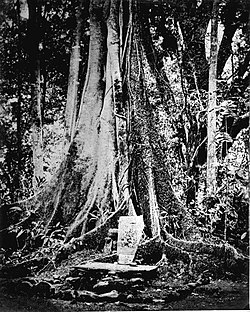Kawali
| Kawali | |
|---|---|
 Sanctuary in Kabuyutan Astana Gede, Kawali. | |
| General information | |
| Town or city | Ciamis Regency, West Java. |
| Country | Indonesia |
| Coordinates | 7°11′24″S 108°21′46″E / 7.1900009°S 108.3628508°E |
Kawali was the capital of Sunda Kingdom during Galuh period, between early 14th to late 15th century. It is located in present day Astana Gede archaeological site, Kawali subdistrict, Ciamis Regency, West Java, Indonesia.[1]: 390
Location
The area is located on the eastern slope of Mount Sawal near the source of the Ci Tanduy river, which runs to the southeast to the Segara Anakan lagoon by the Java's southern ocean (Indian Ocean). The ancient city was located approximately 1 kilometres to the southwest from the alun-alun (square or field) of Kawali town.
The
History
Previously, prior to 14th century, the Galuh capital was located further southeast near the banks of Ci Tanduy river in the area now known as Karang Kamulyan site, near Ciamis town. It is not clear however, when was the time the Galuh capital was moved here. The inscriptions found here confirm that at least for several generations prior to King Niskala Wastu Kancana, the city were already well populated.
Among the Sunda kings ruled here were King
Kawali served as the capital of the kingdom for several generations until Sri Baduga Maharaja moved the center of Sunda government to Pakuan Pajajaran in 1482.
References
- OCLC 318053182. Retrieved 13 June 2018.


